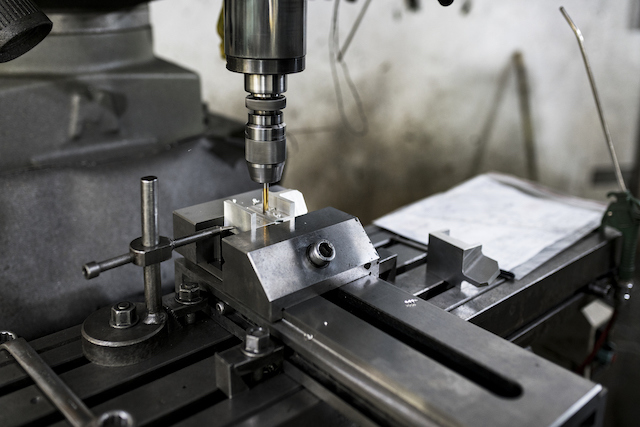
Are you in the process of engineering a novel product in the aerospace field? Smart thinking. Research shows that the aerospace market is slated to grow 7.7% from 2020 to 2025, reaching nearly $431 billion in 2025.
If you need a plastic part for your product, vertical or horizontal milling can help. Vertical and horizontal milling are similar, but they perform different functions. Let’s explore the difference between vertical and horizontal milling.
Vertical milling involves using a machine where the spindle — the part that holds a cutting tool — is vertical.
You can use a vertical milling machine for several functions. These include boring and drilling. They also include slotting and milling. Most computer numerical control (CNC) milling machines have this configuration.
Horizontal milling involves using a machine whose spindle is oriented horizontally.
This type of machine is sturdier and more robust than a vertical milling machine. This means it can handle heavy parts and powerful cutting jobs.
The shape of the horizontal milling machine’s cutter also allows for faster milling compared with a vertical milling machines. In addition, a horizontal miller may be able to use several cutters simultaneously.
Some of these machines also come with rotary tables. This allows their cutting tools to approach workpieces from various angles. This is convenient for any complex milling operation.
A horizontal miller’s cutter looks like a circular saw’s blade. However, it’s generally thicker and smaller.
Vertical milling may be more appropriate for your needs if you’re mostly focusing on a particular side of an object. The object may be a sinking die or a big metal plate.
Meanwhile, horizontal milling is preferable for a more complex project in industries such as the chemical or electrical industry.
Vertical milling comes with several advantages and disadvantages. Let’s examine its pros and cons here.
A vertical milling machine is less complex compared with a horizontal one. This makes it easier and cheaper to maintain and use. In addition, more people use vertical millers, so finding someone with vertical milling experience is generally easier.
Vertical machines are also versatile. Turret mills and bed mills are two types of vertical millers with different applications.
With turret mills, the spindles remain in place, and their bed portions hold the materials being worked on. The beds move vertically or horizontally, which allows the machines to manipulate their materials’ positions in these two directions. A turret mill is usually used for smaller projects.
With bed mills, the spindles are vertical, and the machines move materials horizontally. The spindles may move down and up as needed to turn the materials into their proper shapes. This makes it easy to mill various shapes at different depths.
Bed milling machines are best for projects requiring larger, heavier work pieces.
Yet another benefit of a vertical miller is that it can help you mill a fine feature onto a part with a high tolerance.
Smaller shops also prefer vertical millers since they have lower footprints than vertical millers.
A major disadvantage of vertical milling is that it doesn’t work well for highly complex or high-volume projects.
Vertical millers also can’t accommodate some heavier materials, as they may be difficult to lower and raise. In addition, they can be slower than their horizontal counterparts.
Horizontal milling also comes with a few advantages and disadvantages. Let’s examine its benefits and drawbacks.
Horizontal millers offer more versatility, as they’ll allow you to mill on multiple sides of parts. These machines are also better for weightier items. You may additionally want to use a horizontal miller if you need to cut grooves or slots.
Horizontal mills are especially handy for projects where you have to rapidly remove materials in big sections. They work well even with hard materials. Because horizontal mills remove material quickly, they are excellent for producing large volumes of simple parts.
Horizontal gang millers will also let you use additional cutters for different applications. For instance, you can use gang milling to insert grooves more efficiently. In addition, with some horizontal mills, you can rotate the beds to mill at various angles rather than just milling horizontally.
Finally, chips leave horizontal millers more easily, as horizontal mills use gravity to help chips fall. This leads to better surface finishes for horizontal mills and extends these machines’ life.
A horizontal miller can be more difficult to monitor. That’s because the machine’s parts are harder to see. You may also have a harder time viewing your project when using this type of machine.
Another disadvantage of a horizontal miller is its bigger footprint. It takes up more space, making it difficult to fit in a smaller machine shop.
The difference between vertical and horizontal milling is that vertical milling involves using a milling machine with a cutter positioned vertically, while horizontal millers have cutters oriented horizontally.
Vertical milling, which is less expensive than horizontal milling, is most appropriate for simpler projects. Horizontal milling is best for a complex project.
At Severna, we take pride in offering high-quality plastic component precision machining using millers and other machines. We use efficient methods for fulfilling engineering specifications in various industries, like aerospace and automotive.
Get in touch with us to learn more about our services, and request a free quote today!